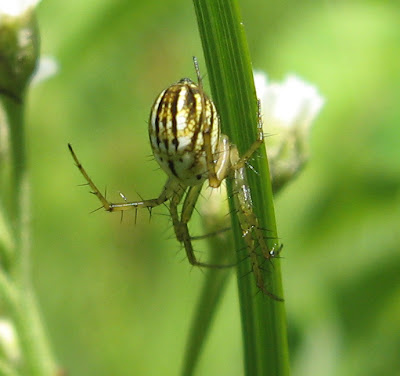... look a little closer at that dead (or alive!) "leaf" or "twig", look under leaves and flowers, and take the time to turn rocks and logs over. Hold these thoughts on a nature hike, otherwise it's easy to miss out on the really interesting, captivating and ofttimes amusing things going on in the wonderful world of nature.
Sometimes you just have to be lucky enough to be in the right place at the right time. I would have overlooked this tiny green spheroid on a grape leaf had I not caught a female Hummingbird Clearwing in the act of ovipositing.
This closeup of the egg really pushes the limits of the camera's macro.
The stabilimentum of a Lined orbweaver (Mangora gibberosa) – and its handicrafter hiding in the background – easily passed by had the light not caught the silk set against a shaded background. A small spider, the adult female is only about 6 mm in length.
At 3 mm the fancifully named Bowl and Doily Weaver (Frontinella communis) is only half as long. Again, it was the web which gave away the spider's location, otherwise it would have been virtually impossible to spot the tiny arachnid despite its bold, contrasting markings.
What appears at first glance to be a blob of mud stuck to the seed pods of a mustard plant is the handiwork of one of nature's own potters, Eumenes fraternus, more commonly known as – what else? – a Potter Wasp.
A photo taken two days later ... this time the picture includes a complimentary Toadflax Brocade Moth (Calophasia lunula).
Like much out there in the living world the tiny urn (I would guesstimate it's diameter to be about 10 mm) is appealing esthetically, but it's purpose is of course functional, not decorative. The female builds, provisions and seals the nest for its larva; I believe the caterpillar within is a Cankerworm. (By the way, this is a different nest that in the photo above and I found it already broken, I didn't crack it open just to examine the contents.)
No worries about overlooking these boldly colored "bees". The black-and-white wasp on top is Philanthus politus – a Beewolf – and aptly named, as the females sting and paralyze various host bee species in order to provision their larvae. The victim on the bottom with the red abdomen is Sphecodes spp., a member of the Halictid Bee (Sweat Bee) family. Generally Halictid bees collect pollen in the manner of many other bees to feed their young, but Sphecodes is a kleptoparasite, laying its eggs in the nests of other Halictic and Plasterer Bees.
Prickly Ash is so-called for good reason, but these "thorns" are the wrong shape and color. And sometimes one chances across the same thorns on a tree such as Boxelder, where they are definitely out of character. A closer look reveals that these are cleverly disguised Flatid Planthoppers, probably Metcalfa pruinosa. It's fascinating that in order for the deception to succeed the insects must instinctively act as a group and stagger themselves along the twig. A lone planthopper on a twig would hardly look like a thorn, would it?
The long, lacy, almost ethereal fronds of this fern growing in the moist woodland soil at the Vanderwater Conservation Area caught my eye. An expert would no doubt have known what these were, but as a novice to the world of non-flowering plants, one fern looks much like another to me. To facilitate identification I make a practice of studying and photographing the overall aspect of the plants as a group, the fronds, the pinnae, the stipe ...
... and the spore-producing sori on the undersides of the fertile fronds – which also bore small green growths that proved to be pivotal in establishing the identity of the plant. In point of fact, this is a Bulblet Fern (Cystopteris bulbifera) and the little bulblets will eventually drop off and grow into new ferns.
Always look twice indeed – an ant with a ginormous blue-green head scuttling among the debris on the forest floor certainly called for a double take.
Attributing human qualities to an insect may not be good science, but it does seem as if this Katydid nymph is staring back at the camera in a bellicose manner. An insect with attitude – "What're ya'll lookin' at?"




















